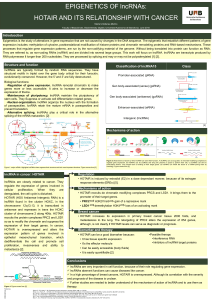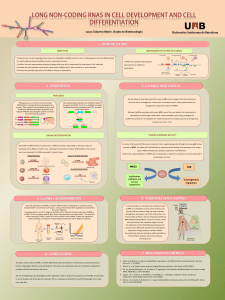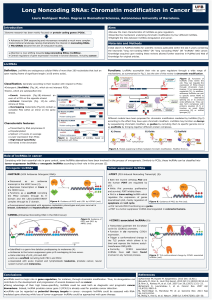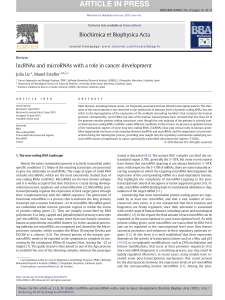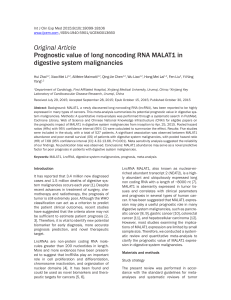Long non-coding RNAs and The Hallmarks of Cancer: Linc
publicité
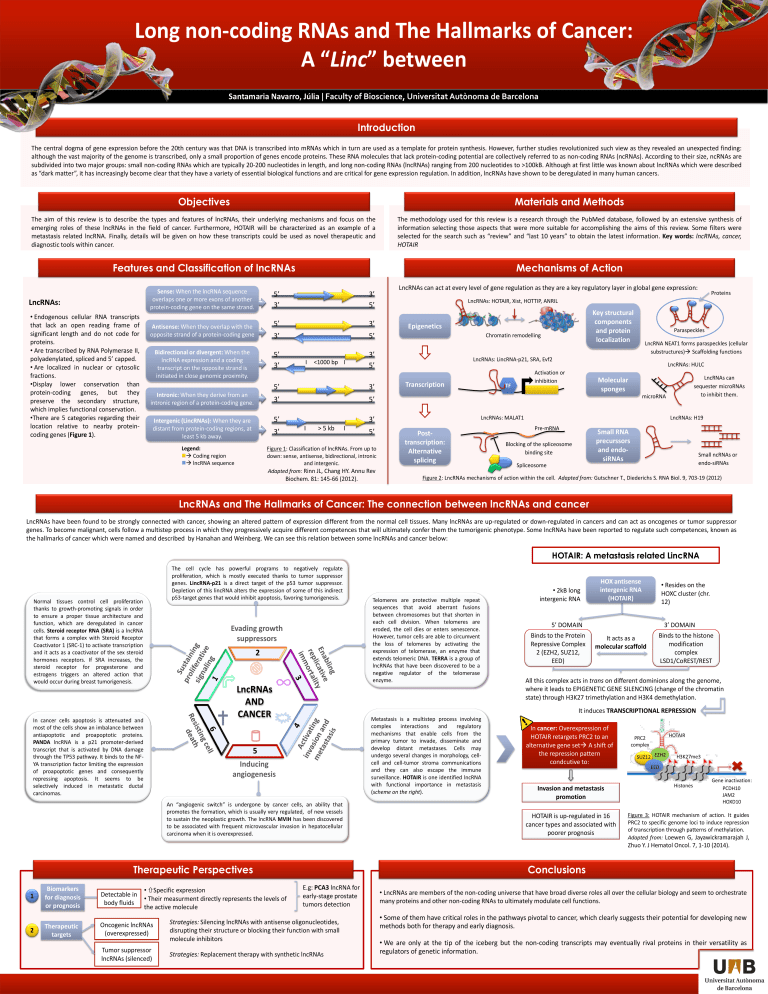
Long non-coding RNAs and The Hallmarks of Cancer: A “Linc” between Santamaria Navarro, Júlia | Faculty of Bioscience, Universitat Autònoma de Barcelona Introduction The central dogma of gene expression before the 20th century was that DNA is transcribed into mRNAs which in turn are used as a template for protein synthesis. However, further studies revolutionized such view as they revealed an unexpected finding: although the vast majority of the genome is transcribed, only a small proportion of genes encode proteins. These RNA molecules that lack protein-coding potential are collectively referred to as non-coding RNAs (ncRNAs). According to their size, ncRNAs are subdivided into two major groups: small non-coding RNAs which are typically 20-200 nucleotides in length, and long non-coding RNAs (lncRNAs) ranging from 200 nucleotides to >100kB. Although at first little was known about lncRNAs which were described as “dark matter”, it has increasingly become clear that they have a variety of essential biological functions and are critical for gene expression regulation. In addition, lncRNAs have shown to be deregulated in many human cancers. Objectives Materials and Methods The aim of this review is to describe the types and features of lncRNAs, their underlying mechanisms and focus on the emerging roles of these lncRNAs in the field of cancer. Furthermore, HOTAIR will be characterized as an example of a metastasis related lncRNA. Finally, details will be given on how these transcripts could be used as novel therapeutic and diagnostic tools within cancer. The methodology used for this review is a research through the PubMed database, followed by an extensive synthesis of information selecting those aspects that were more suitable for accomplishing the aims of this review. Some filters were selected for the search such as “review” and “last 10 years” to obtain the latest information. Key words: lncRNAs, cancer, HOTAIR Features and Classification of lncRNAs Mechanisms of Action Sense: When the lncRNA sequence overlaps one or more exons of another protein-coding gene on the same strand. LncRNAs: • Endogenous cellular RNA transcripts that lack an open reading frame of significant length and do not code for proteins. • Are transcribed by RNA Polymerase II, polyadenylated, spliced and 5’ capped. • Are localized in nuclear or cytosolic fractions. •Display lower conservation than protein-coding genes, but they preserve the secondary structure, which implies functional conservation. •There are 5 categories regarding their location relative to nearby proteincoding genes (Figure 1). Antisense: When they overlap with the opposite strand of a protein-coding gene Bidirectional or divergent: When the lncRNA expression and a coding transcript on the opposite strand is initiated in close genomic proximity. 5’ 3’ 3’ 5’ 5’ 3’ 3’ 5’ 5’ 3’ Intronic: When they derive from an intronic region of a protein-coding gene. Intergenic (LincRNAs): When they are distant from protein-coding regions, at least 5 kb away. I 3’ 3’ 5’ 5’ 3’ I > 5 kb I 5’ Figure 1: Classification of lncRNAs. From up to down: sense, antisense, bidirectional, intronic and intergenic. Adapted from: Rinn JL, Chang HY. Annu Rev Biochem. 81: 145-66 (2012). Proteins LncRNAs: HOTAIR, Xist, HOTTIP, ANRIL Key structural components and protein localization Epigenetics Chromatin remodelling 3’ 5’ 5’ 3’ Legend: Coding region lncRNA sequence <1000 bp I LncRNAs can act at every level of gene regulation as they are a key regulatory layer in global gene expression: Paraspeckles LncRNA NEAT1 forms paraspeckles (cellular substructures) Scaffolding functions LncRNAs: LincRNA-p21, SRA, Evf2 Transcription LncRNAs: HULC Activation or inhibition TF LncRNAs can sequester microRNAs to inhibit them. Molecular sponges microRNA LncRNAs: MALAT1 Posttranscription: Alternative splicing LncRNAs: H19 Pre-mRNA Small RNA precurssors and endosiRNAs Blocking of the spliceosome binding site Spliceosome Small ncRNAs or endo-siRNAs Figure 2: LncRNAs mechanisms of action within the cell. Adapted from: Gutschner T., Diederichs S. RNA Biol. 9, 703-19 (2012) LncRNAs and The Hallmarks of Cancer: The connection between lncRNAs and cancer LncRNAs have been found to be strongly connected with cancer, showing an altered pattern of expression different from the normal cell tissues. Many lncRNAs are up-regulated or down-regulated in cancers and can act as oncogenes or tumor suppressor genes. To become malignant, cells follow a multistep process in which they progressively acquire different competences that will ultimately confer them the tumorigenic phenotype. Some lncRNAs have been reported to regulate such competences, known as the hallmarks of cancer which were named and described by Hanahan and Weinberg. We can see this relation between some lncRNAs and cancer below: HOTAIR: A metastasis related LincRNA The cell cycle has powerful programs to negatively regulate proliferation, which is mostly executed thanks to tumor suppressor genes. LincRNA-p21 is a direct target of the p53 tumor suppressor. Depletion of this lincRNA alters the expression of some of this indirect p53-target genes that would inhibit apoptosis, favoring tumorigenesis. Normal tissues control cell proliferation thanks to growth-promoting signals in order to ensure a proper tissue architecture and function, which are deregulated in cancer cells. Steroid receptor RNA (SRA) is a lncRNA that forms a complex with Steroid Receptor Coactivator 1 (SRC-1) to activate transcription and it acts as a coactivator of the sex steroid hormones receptors. If SRA increases, the steroid receptor for progesterone and estrogens triggers an altered action that would occur during breast tumorigenesis. Evading growth suppressors 2 LncRNAs ∞ AND CANCER In cancer cells apoptosis is attenuated and most of the cells show an imbalance between antiapoptotic and proapoptotic proteins. PANDA lncRNA is a p21 promoter-derived transcript that is activated by DNA damage through the TP53 pathway. It binds to the NFYA transcription factor limiting the expression of proapoptotic genes and consequently repressing apoptosis. It seems to be selectively induced in metastatic ductal carcinomas. Telomeres are protective multiple repeat sequences that avoid aberrant fusions between chromosomes but that shorten in each cell division. When telomeres are eroded, the cell dies or enters senescence. However, tumor cells are able to circumvent the loss of telomeres by activating the expression of telomerase, an enzyme that extends telomeric DNA. TERRA is a group of lncRNAs that have been discovered to be a negative regulator of the telomerase enzyme. • 2kB long intergenic RNA HOX antisense intergenic RNA (HOTAIR) • Resides on the HOXC cluster (chr. 12) 5’ DOMAIN Binds to the Protein Repressive Complex 2 (EZH2, SUZ12, EED) 3’ DOMAIN It acts as a molecular scaffold Binds to the histone modification complex LSD1/CoREST/REST All this complex acts in trans on different dominions along the genome, where it leads to EPIGENETIC GENE SILENCING (change of the chromatin state) through H3K27 trimethylation and H3K4 demethylation. It induces TRANSCRIPTIONAL REPRESSION Metastasis is a multistep process involving complex interactions and regulatory mechanisms that enable cells from the primary tumor to invade, disseminate and develop distant metastases. Cells may undergo several changes in morphology, cellcell and cell-tumor stroma communications and they can also escape the immune surveillance. HOTAIR is one identified lncRNA with functional importance in metastasis (scheme on the right). 5 Inducing angiogenesis An “angiogenic switch” is undergone by cancer cells, an ability that promotes the formation, which is usually very regulated, of new vessels to sustain the neoplastic growth. The lncRNA MVIH has been discovered to be associated with frequent microvascular invasion in hepatocellular carcinoma when it is overexpressed. In cancer: Overexpression of HOTAIR retargets PRC2 to an alternative gene set A shift of the repression pattern condcutive to: Invasion and metastasis promotion HOTAIR is up-regulated in 16 cancer types and associated with poorer prognosis HOTAIR PRC2 complex SUZ12 EZH2 H3K27me3 EED Histones Gene inactivation: PCDH10 JAM2 HOXD10 Figure 3: HOTAIR mechanism of action. It guides PRC2 to specific genome loci to induce repression of transcription through patterns of methylation. Adapted from: Loewen G, Jayawickramarajah J, Zhuo Y. J Hematol Oncol. 7, 1-10 (2014). Therapeutic Perspectives 1 2 Biomarkers for diagnosis or prognosis Detectable in body fluids Therapeutic targets Oncogenic lncRNAs (overexpressed) • Specific expression • Their measurment directly represents the levels of the active molecule Tumor suppressor lncRNAs (silenced) Conclusions E.g: PCA3 lncRNA for early-stage prostate tumors detection Strategies: Silencing lncRNAs with antisense oligonucleotides, disrupting their structure or blocking their function with small molecule inhibitors Strategies: Replacement therapy with synthetic lncRNAs • LncRNAs are members of the non-coding universe that have broad diverse roles all over the cellular biology and seem to orchestrate many proteins and other non-coding RNAs to ultimately modulate cell functions. • Some of them have critical roles in the pathways pivotal to cancer, which clearly suggests their potential for developing new methods both for therapy and early diagnosis. • We are only at the tip of the iceberg but the non-coding transcripts may eventually rival proteins in their versatility as regulators of genetic information.
